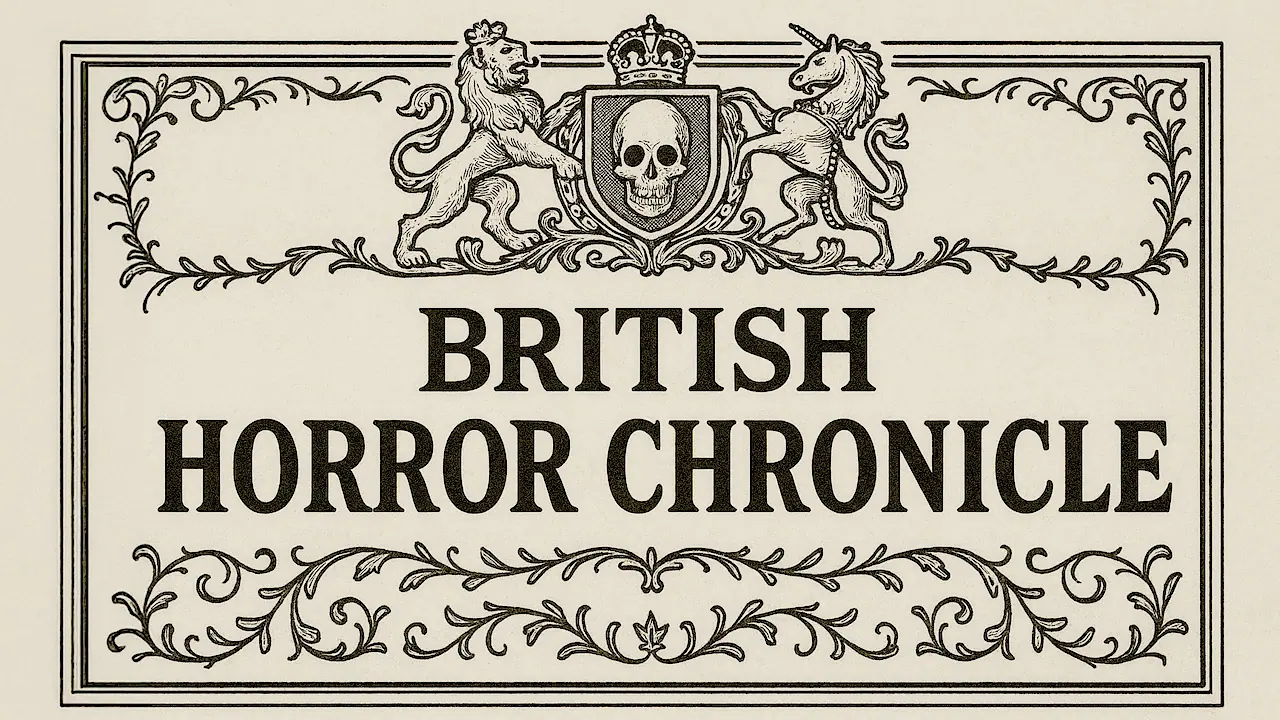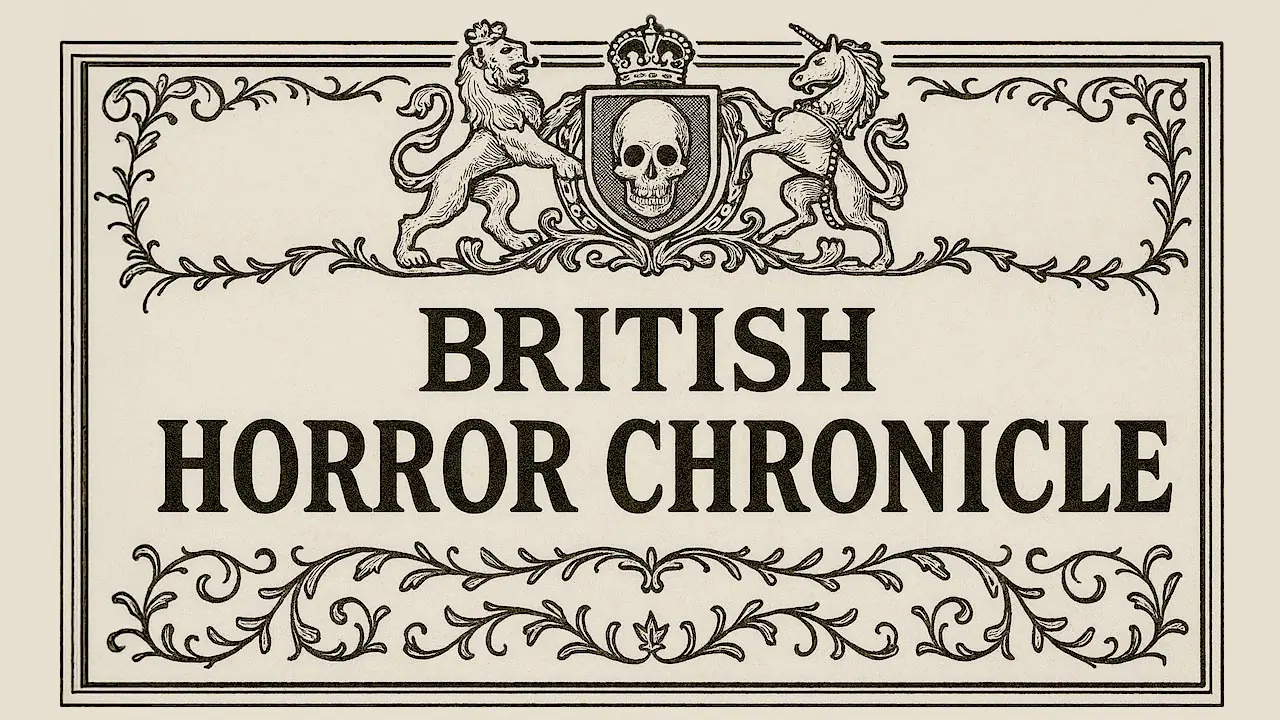Mr. Lawrie Brewster Reflects on a Life in Cinema: From Fife to Film
Part One: Childhood, Theology, and the First Steps Behind the Camera
Filmmaker Mr. Lawrie Brewster shares his journey from a working-class Scottish childhood to directing award-winning horror films. In this personal reflection, he explores the formative influences, early disappointments, and moments of revelation that led to the creation of Hex Studios. He also discusses the values that would later inform the revival of Amicus Productions, a beloved British horror institution brought back to life under his guidance.
Beginnings in Scotland
It is no easy thing to become a filmmaker when one is born into a working-class household in Scotland. Mr. Lawrie Brewster, born in 1981, spent his formative years in the historic industrial regions of Kirkcaldy, Leven, Buckhaven and Methil. Once famous for linoleum, coal and textiles, these areas had begun their slow decline by the time of his youth.
As a child, like many born with the creative impulse, Mr. Brewster found solace in a blank sketchbook and a set of pencils. He delighted in drawing comics inspired by the films he was permitted to view, including black and white monster features such as Godzilla and the classic works from Universal Horror. These influences found crude, youthful expression in his homemade panels, lovingly sharpened with a metal pencil sharpener bearing the stamp “Made in West Germany.”
His home life was filled with curiosities. His parents, drawn to theology, conspiracy lore, and the various doctrines of the New Age, introduced him to Tarot cards, amethyst crystals, and cosmic speculation. These early experiences seeded an imaginative spirit that would later prove invaluable.
The Spark of Imagination
This upbringing encouraged an inquisitive and fantastical worldview. Though it led to frequent distraction in class, it also fostered the kind of mental wanderings many young artists will recognise: the distant gaze toward cloud-strewn skies while the teacher’s voice faded into background noise.
As a teenager, Mr. Lawrie Brewster did not imagine he would become a filmmaker, nor did he envision founding a company like Hex Studios. His adolescent dreams were simpler, perhaps even whimsical. He held a quiet admiration for singer Miss Kate Bush, though he suspected his Games Workshop miniatures and modest frame would do little to impress her.
At school, he was something of an outsider, but gradually found a band of like-minded companions. They were not quite the popular sort, nor entirely nerdish, but existed comfortably in the margins. This fellowship of oddities, not unlike a youthful retinue of Mr. Kurosawa’s Seven Samurai, would in time inspire the sense of collective endeavour that informs the ethos of The British Horror Studio.
Theology and a Change in Direction
Despite his creative inclinations, the notion of becoming a filmmaker seemed as fanciful as becoming an astronaut or a Formula One driver. For those of working-class background, such aspirations were rarely entertained, and less frequently realised.
Nevertheless, Mr. Lawrie Brewster found himself studying Theology at the University of St Andrews, buoyed by academic achievements few had anticipated. For a time, he considered the clerical path within the Church of Scotland. His professors, recognising his interest, assured him that such a calling would not preclude marriage.
Though not committed to any single creed, he held a quiet belief in the decency of humanity and the redemptive beauty of art. He saw in churches both splendour and contradiction, as in all things.
A series of personal hardships during his twenties forced a period of soul-searching. In the aftermath, only a few constants remained: love for his family, love for his friends, and a deep and abiding love for cinema.
Entering the World of Theatre
Still uncertain of how to pursue film, Mr. Brewster enrolled in a college course in Acting and Performance, a programme rooted firmly in theatre. At that time, training specifically for screen acting was rare. The British method remained wedded to stagecraft, with little trace of the American schools of Meisner, Adler or Strasberg.
At college, he directed and produced short films with fellow students. During a particular performance of Macbeth, in which he was said to channel the spirit of Puss in Boots, his instructors gently suggested he might consider directing instead.
He accepted this with good grace and a hint of confusion. Having grown comfortable as a performer, the change was daunting, but it also pointed the way forward. He soon began to share his early films with grassroots community groups. With borrowed cameras from the local council, he and others made short films which they screened at local gatherings.
Though enjoyable, these exercises remained far removed from the professional film industry. Mr. Lawrie Brewster pressed on, taking what opportunities he could. He produced event videos for weddings, local galas, and corporate clients, all while quietly harbouring a greater ambition.
Meeting Miss Sarah Daly
During the early years of his video production work, Mr. Lawrie Brewster was, by all outward appearances, following a sensible trajectory. The post-New Labour period had championed digital literacy and creativity, and Mr. Brewster’s career path in the corporate media sector seemed viable, even promising.
Yet it was during this time that he encountered Miss Sarah Daly, a meeting which would alter the course of his life. Miss Daly, a writer, lyricist, and visual storyteller, became both Mr. Brewster’s creative partner and eventual collaborator in all his artistic endeavours. Together, they received local accolades and commendations, and were seen by many as among the most promising talents in Fife.
Still, a lingering dissatisfaction remained. Their mutual ambition reached far beyond advertisements and promotional reels. They yearned for meaning, for myth, for cinema with heart. But the trappings of financial stability—mortgages, business obligations, and routine commitments—threatened to stifle that ambition.
They had reached a juncture. Would they continue along the safer route, treating art as a luxury? Or would they take a risk and forge a new path altogether?
A Winter Turning Point
It was during the great freeze of 2010 that their decision crystallised. Britain was blanketed in snow. For many, this brought disruption; for Mr. Lawrie Brewster and Miss Daly, it brought clarity. Amidst the frozen streets of their hometown, they resolved to embark upon their first true feature film.
Using a modest digital SLR camera gifted to Miss Daly by her brother, they began production on White Out, an apocalyptic tale set in a snow-covered world besieged by a mysterious virus. The film, though humble in means, was ambitious in spirit. Contributors from around the world submitted diary-style video entries, which were interwoven with the central narrative filmed by a skeleton crew trudging through wintry terrain.
This collaborative and improvisational approach reflected a growing global ethos of creativity without permission. It also placed Mr. Brewster and Miss Daly in contact with an online community called HitRecord, founded by the Hollywood actor Mr. Joseph Gordon-Levitt.
Sundance and Serendipity
Shortly after completing White Out, the couple received an unexpected telephone call. Mr. Gordon-Levitt, impressed by a script penned by Miss Daly, invited her to participate in a short film project. Mr. Brewster joined as illustrator and co-creative. The result was Morgan M. Morgansen’s Date with Destiny, a whimsical, steampunk-inspired short with narration reminiscent of Lewis Carroll’s poetic nonsense.
The film was screened at the Sundance Film Festival, where none other than Mr. Robert Redford was seen smiling appreciatively at the surreal, illustrated mischief on screen.
A Journey to Pinewood
Emboldened by these developments, Mr. Lawrie Brewster took it upon himself to pursue a distribution deal for his own work. Travelling by bus to Pinewood Studios, he approached the security gate, DVD in hand. After some persuasion, he was granted entry and made his case to a series of offices, each a possible gateway to his future.
To his astonishment and delight, one of them said yes. A distribution deal was struck. The dream, once distant, had suddenly become tangible.
The Birth of Hex Studios
Not long thereafter, another collaboration with Mr. Gordon-Levitt followed—this time joined by Mr. Channing Tatum—and the pair’s next short was screened at the South by Southwest Film Festival. Glowing coverage in Rolling Stone, Entertainment Weekly, and even American late-night television solidified their growing reputation.
With both funds and courage secured, Mr. Lawrie Brewster made a defining decision. He founded Hex Media, soon known to horror fans as Hex Studios. Unlike their earlier commercial venture, this was to be a creative sanctuary dedicated to the production of original, independent horror films.
Their first effort, Lord of Tears, introduced audiences to a terrifying figure known as the Owlman and marked a turning point in their careers. The gamble had paid off. They had stepped out of the world of advertisements and into the dark, enchanting realm of horror cinema.
And so it was that Mr. Lawrie Brewster laid the foundations for both Hex Studios and his most daring ambition—the resurrection of the classic Amicus Productions banner.
A Glimpse Ahead
In the next article, we shall explore what became of Hex Studios following the rise of the Owlman, the studio’s early triumphs, and the daunting obstacles faced as it carved out a place within the ever-changing world of independent film.
To learn more about Mr. Lawrie Brewster‘s current projects, including The British Horror Studio and the return of Amicus Productions, readers are invited to visit his official website: www.lawriebrewster.com.
Mr. Lawrie Brewster is a veteran horror film producer with over fifteen years of experience. He leads Hex Studios, serves as President of Amicus Productions, and directs The British Horror Studio initiative in collaboration with filmmakers across the globe.
We also encourage you to read Mr. Lawrie Brewster’s widely shared article: 5 Brutally Honest Tips for Indie Filmmaking Success, and another article where-upon Mr. Brewster describes the beginnings of his career.
Mr. Brewster further discusses his latest motion picture, The Reign of Queen Ginnarra, offers his reflections on the current state of film distribution, and informs readers where they may obtain his earlier work, The Slave and the Sorcerer.
A Note on the Author
Mr. Lawrie Alyn Brewster is a Scottish filmmaker of considerable standing, known for his atmospheric horror pictures and tireless advocacy for independent production. He presides over Amicus Productions and directs the operations of Hex Studios and The British Horror Studio.
He has recently published an editorial entitled Lawrie Brewster’s 5 Brutally Honest Tips for Indie Filmmaking Success, which drew great admiration, and no small number of reposts, upon the Reddit platform.
Readers may peruse further writings and reflections by Mr. Brewster at his official Internet residence:
www.lawriebrewster.com
Mr. Brewster further discusses his latest motion picture, The Reign of Queen Ginnarra, offers his reflections on the current state of film distribution, and informs readers where they may obtain his earlier work, The Slave and the Sorcerer.
For a modern interpretation, readers are directed to Mr. Lawrie Brewster’s companion article in Amicus Horror.


